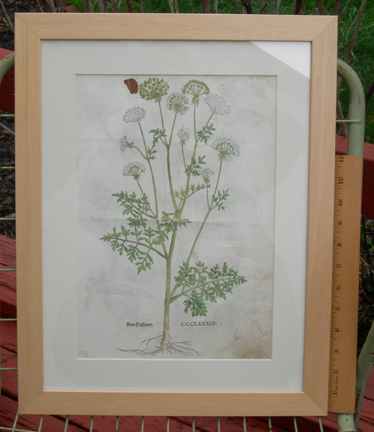About a year ago, I visited a friend in Albany, CA, and discovered a collection of early scientific illustration in his home. So after I started this blog, I asked if he would be willing to send me some photographs of these illustrations. Not only did he send me pictures, but he was so generous that he also type up a page of information about the history of early illustrated prints. Here are photos and his descriptions of these prints (with minor paraphrasing):
“Prior to about 1440, books were written by hand and illustrations were also done by artists by hand.
About 1440, with the invention of movable metal type by Johann Gutenberg, book printing grew rapidly. Among the first illustrated books printed were Herbals–books with woodcuts of plants. Woodcut plates were printed in black outline and often hand-colored using watercolors. These plates below were from the Herbal Hortus Sanitatus printed in Mainz in 1490 and probably colored sometime in the 18th century. The plates and texts were printed on heavy cotton or linen paper. The early Herbals are still around in old antique shops, the internet, or other unusual sources, but usually only pages removed from them are to be found. They are not too expensive but not that easy to come across.


Line plates were printed from the earliest times of publishing until well into the 19th century. Early scientific books were usually hand-colored by housewives who were paid per plate. The Audubon and Wilson bird books were done this way. Also see examples below:


Left (Top): Wild Turkey, Male and Female. Drawn from Nature by Titian R. Peale. Engraved by W. H. Lizars
Right (Bottom): American Sparrow Hawk, Field Sparrow, Tree Sparrow, Song Sparrow, Chipping Sparrow, Song Bird. Drawn from Nature by A. Wilson. Engraved by W. H. Lizars
Early in the 19th century, plates were prepared by etching images on heavy clay blocks–one block for each primary color. The blocks were inked and printed three times–once for each color. This method was slow and very costly.


Left (Top): Birds–Plate I, From the Pacific Railroad Surveys ‘U.S.P.R.R. Exp & Surveys–32nd Parallel (West)’
Right (Bottom): Birds–Plate VIII, From the Pacific Railroad Surveys ‘U.S.P.R.R. Exp & Surveys–Cal & Oregon’
By the middle 1800’s, lithography was introduced where ‘dots’ of the primary colors were printed resulting in color illustrations, much like the modified versions we still use today. High quality illustrations used up to nine plates of different colors per printed sheet–very expensive but used in fine art books and limited edition art plates. Each plate had to be printed over using the shade of color and the printings have to be accurately ‘registered,’ or lined up.
Paper changed greatly during the advent of printing. The earliest paper was produced by putting a fiber slurry onto a metal sheet and peeling it off after drying. By about 1520, paper was made by dipping a fine screen into the slurry. This paper, used until the end of the 18th century, had watermarks on the screen and was called ‘laid paper.’ Today, (wove) paper is made using similar method of the earliest paper but done automatically on rollers.”
Thanks to Ted of Albany, CA for providing the photos and contents.